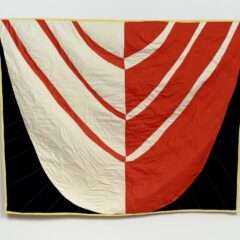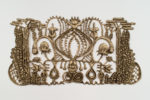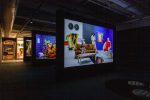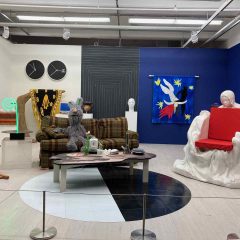Fleisher-Ollman Gallery in Center City is in the midst of a fleecy, Frankenstein’s monster of a show assembled by the one and only Jayson Musson. You may also know this hilariously controversial artist and instigator by his alter-ego Hennessy Youngman, the Def Jam-style critic of YouTube’s “Art Thoughtz”. His current show entitled “A True Fiend’s Weight” pieces together canvases from strips of Coogi sweaters, the brightly colored garments popularized by the likes of Bill Cosby and the Notorious B.I.G.
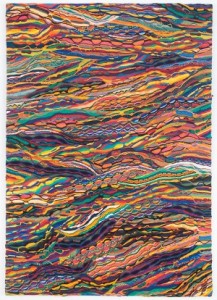
Upon entering the wide open space of the Fleisher-Ollman gallery, one is confronted by varying sizes of stretched fabric wall-hangings in the boldest and most obnoxious of color schemes. While it would be easy to consider that the gallery wine was dosed with LSD, the psychedelic implications are really only thread deep. In such a hard-edged, concrete room these plush creations are truly inviting and comforting. Much like a child’s blanket or stuffed animal, they provide a textural break from the slabs of steel and act as a sort of cuddly mental pacifier.
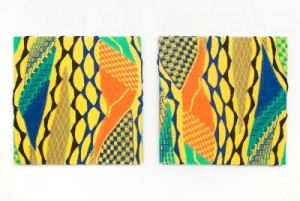
Beyond their soothing visual effects (it’s bad etiquette to actually snuggle with the art), these swaths also provide a degree of sound-dampening, making them akin to soundproofing foam or other aural accoutrements. While their softness as bits of actual sweaters provided real warming function in a former life, their only insulating purpose as reincarnations is indirect and auditory; one could almost say they are merely echoes of their past selves – and muffled ones at that.
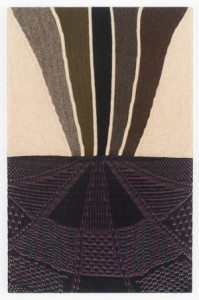
All of the works are intriguing, in no small part due to their lengthy, esoteric titles, but a few stand out from the crowd. Many of the compositions are similar in their wily, fabric framing but a few emerge as entirely unique, even amidst the clashing colors. The structured layout of “Kazimir’s Folly”, for instance, is a distinct departure from every other artwork in the show. Here, a horizon line splits the work in two, and rays from some distant energy source travel toward the viewer from a sort of vanishing point. The ‘ground’ in this piece is full of mottled, dark shades of purple and blue, although the light beams are strangely composed of even more drab grays, browns, and black.
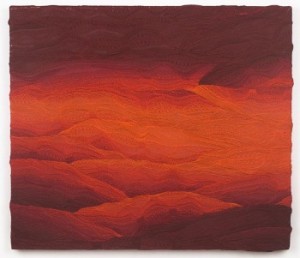
Elsewhere, Musson reduces his pre-knitted palette to only shades of red. In “South of the Border, West of the Sun”, the artist works less with maddeningly repeated motifs and instead bathes the viewer in a fiery sea of crimson and almost-orange. The bottom seems to ripple with waves, or perhaps more appropriately, hot, dry sand dunes. Every work is texturally complex at a close vantage point since it is composed of many individual fibers, and an additional element of this is the ability to see straight through the small gaps to the white walls behind. This adds depth and transparency in such a way that the art becomes paradoxically more spatial and more ethereal.
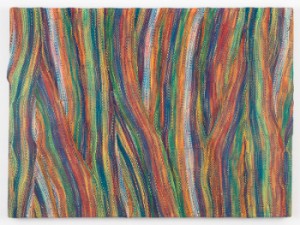
Perhaps more telling of the majority of works in the exhibit is “The White Noise of Modernism”, a colorful, layered blending of Coogis into a branching, abstract expressionist-like arrangement. Much like television static or cosmic background radiation, Musson’s fuzzy mash-up nudges Clyfford Still and his formal contemporaries aside into the enveloping, atmospheric noise of art history and times past. Now that visual overstimulation and wild juxtaposition have become art orthodoxy, the canvases of the mid-20th century quaintly and quietly fade into the distance.
Not unlike the way one would approach a Rothko color field to wade in and be absorbed, Jayson Musson’s “A True Fiend’s Weight” is an immersive experience, but with an appropriative twist. As a whole, the show is at once silently soft and visually boisterous – loud like the garments from whence it came. Its chaotic stitches mirror the disorder of the universe but also provide a very real sense of solace.
Musson’s work will be on display at Fleisher-Ollman Gallery through January 26.


